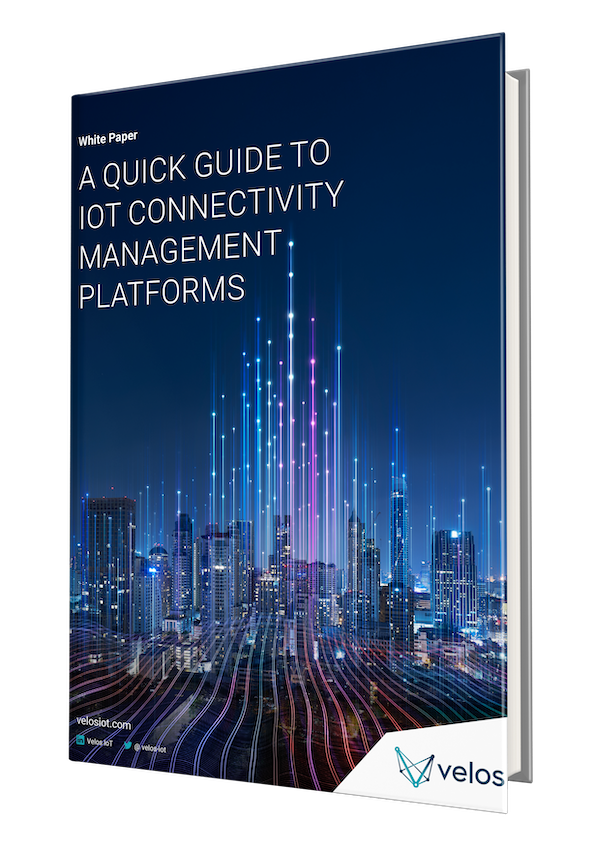IoT Connectivity management platforms are essential tools for managing global IoT connectivity.
The issue is, these tools are as new (and often as confusing) as the IoT industry itself. This, coupled with the immaturity of the industry, can make it difficult to sort between the different platforms available. Learn more about the types of IoT platforms.
In this concise but comprehensive guide, we'll walk you through everything you need to know about IoT connectivity management platforms and their role in your IoT success.
What is an IoT connectivity management platform (CMP)?
An IoT connectivity management platform, also known as a CMP, is a solution that allows customers to deliver new types of services, experiences and business models that will drive business growth. It significantly simplifies IoT operation automation and helps with the management, control and automation of SIM, eSIM and device life cycles. To better understand how a CMP can benefit you, it is useful to understand the components of an IoT ecosystem.
First, you have the hardware components consisting of the cellular radio module, the SIM card, the application and the device itself. These are the physical, deployable parts of your IoT ecosystem. Then, you have the software that runs on these physical parts, which together create your IoT solution.
If your IoT system is made up of smart light bulbs, the light bulb would be your IoT edge solution, and the program that makes your lightbulb "smart" is the software.
Cellular connectivity is the third component of your IoT ecosystem. Cellular connectivity can be based on 2G, 3G, LTE (4G), LTE-M or 5G depending on your specific use case. In a closed location, such as an office building, you might need to use a cellular connectivity method that can penetrate through thick walls. But if your devices are out in the field in rural areas you need a cellular method that can reach long distances, without compromising the quality.
IoT Connectivity management platforms are what enables you to manage parts of your hardware components, parts of the software that runs on these hardware components, and most importantly, enables you to manage the different types of cellular connectivity in a cost-efficient way. You can compare a CMP to your home heating system, in which you can set when the heating system should be on, the temperature, which room to heat and also to sync to the weather outside.
The benefits of using an IoT connectivity management platform
Simplify your IoT deployment
Each IoT deployment will be different to the next. Some might be entirely local, while others are global; you might be deploying stationary or mobile devices or a combination of the two.
This adds an immense amount of complexity — unless you use a CMP.
Control costs
The complexity of your IoT rollout impacts its cost too. Say your devices will be shipped and deployed across three global markets, that’s a lot of time (and cost) spent negotiating local contracts and establishing integrations as well.
CMPs empower you to streamline worldwide IoT projects into a single, cost-effective solution.
Boost your security
Most businesses involved in IoT are aware of how many security risks it poses. Your hardware, software, and network(s) all present unique risks. A robust CMP can help you tackle network-related risks, which is arguably the most important aspect of your IoT security.
The features and functions of a cutting-edge CMP
The way that each CMP delivers on these benefits will vary from platform to platform. Generally speaking, though, you should see the features described below implemented in some shape or form in most CMPs (and any CMPs worth your attention).
Support from the experts
One of the critical features offered by CMPs is access to a support team of experts. Each CMP is (generally speaking) produced by a team of professionals who have worked with countless other IoT companies such as yourself.
Additionally, this team has experience and expertise in the field of managing IoT solutions, cellular connectivity and network services. So when a CMP offers tech support with its platform, you get access to a team who can help you resolve problems, overcome challenges and better understand your industry.
A globalised solution
While some IoT solutions are localised to a small space, the vast majority of IoT companies are looking to deploy in various regions. This can lead to unexpected legal and taxation ramifications. Not only will different regions within your own country have varying regulations, but different countries will have wildly different policies.
Connectivity bears the brunt of these challenges. But an effective CMP will have anticipated and resolved these challenges already, offering you a platform that's as effective at home as it is abroad.
Deploy eSIM solutions
During the development of your IoT edge solution, our recommendation is to always use a SIM card that supports eUICC (hardware) and eSIM (software). This ensures you have a working IoT solution and enables you to change the MNO after deployment. A CMP that can properly support eUICC is key to realising the full benefits of an eSIM.
Manage your IoT devices throughout their lifecycle
An effective CMP will allow you to manage your IoT solution at every stage of its lifecycle.
This starts with the development of your hardware, the roll-out of your product, the activation in a specific country/region and the day-to-day management of your deployed solutions.
As your IoT solution is deployed and begins to mature, a CMP can help you keep track of your devices, view how much data they consume,
collect analytics, perform maintenance, and recover them after they’re no longer in service.
You may also be interested in the below articles:
What to consider when choosing an IoT platform for Smart Cities?
How can IoT Platforms help with smart city transformation in South Africa?
Velos IoT Nomad: the IoT connectivity platform that offers even more
The features listed above should be found in any quality CMP, but these are only the basics of what CMPs are capable of delivering. Velos IoT believes that IoT businesses should also have access to a high-value, low-cost connectivity management platform regardless of how big or small their operation is.
That's why we created Velos IoT Nomad — an IoT connectivity management platform with a truly unique value proposition.
1. One platform, multi-carrier support
Velos IoT Nomad is used by some of the biggest telecoms in the world. This means that Nomad is not only built on the latest IoT and connectivity technology but centuries of hands-on communications expertise as well.
It’s thanks to this expertise and status that Velos IoT can offer multi-carrier support to Velos IoT Nomad users. The platform is fully integrated with the latest GSMA Subscription Management standard - SGP 0.2 V3.2, enabling the user to not only get access to the Velos IoT profile but also to other local profiles around the world through eSIM.
The Velos IoT Nomad offers an orchestration layer in which the user can provision, manage and active eSIM profiles either manually or through automation rules. The application is eSIM Connectivity Hub and offers one UI/API, one invoice and one SIM card.
By using eSIM together with the Velos IoT Nomad IoT businesses can connect to multiple carriers (including or excluding Velos IoT) while enjoying the simple management and cost-controlling benefits of a single platform.
2. A future-proof solution
The IoT industry is still in a continuous state of flux. The tech is changing, improving and being used in new and exciting ways.
For IoT businesses to keep up, they need a CMP that’s as flexible and adaptable as they are. Velos IoT Nomad is built for the changes the IoT industry inevitably presents. In the platform, you’ll find features like order, account and billing management, troubleshooting, API support, automation, eSIM support, long-term scalability, and consistent updates to the service.
These features give Velos IoT Nomad users the peace of mind that they’ll be able to stay with the platform for many years to come.
3. Monetise your IoT deployment with ease
One of the most unique offerings of the Velos IoT Nomad connectivity management platform is that it provides users with the ability to monetise through their IoT devices. IoT businesses can accept payments, send invoices, and manage subscriptions for their own customers through the Velos IoT Nomad platform.
You can think of this as having the features of a service like Stripe or Shopify built into your IoT system. Depending on your business model, this feature alone can ensure that you receive a sizeable ROI by switching to Velos IoT Nomad.
4. A lean, all-in-one option
Velos IoT Nomad users don’t need to worry about their ROI as much as users of other platforms do. That’s because Velos IoT Nomad costs tens of thousands of pounds less than competing platforms.
Not to mention that Velos IoT Nomad is an all-in-one solution, too. Users will be able to reduce the number of systems and services they rely on to support their IoT solution in the field, adding to the savings.
5. Deliver your value across all sectors
With years of experience in IoT, Velos IoT knows that IoT businesses operate across a broad variety of sectors. Everything from agriculture, healthcare, telematics, transportation, retail and energy is encompassed. And new industries like smart cities have been created by the emergence of IoT.
Velos IoT Nomad is a horizontal CMP that can support your business, regardless of which sector(s), you operate in. The solution is flexible and robust enough to provide the features you need without adding excessive costs for features you’ll never use. And if you need to expand the feature set in Velos IoT Nomad, it can easily be integrated into other platforms such as device management platforms, IoT application enablement platforms, through its rich REST/SOAP or microservices API.
Download your free copy of Velos IoT Nomad Platform Overview to learn more about Nomad's capabilities and how it can help you scale and manage your IoT business.
Velos IoT eSIM Connectivity Hub

Use Velos IoT's eSIM Connectivity Hub to monitor and manage your global eSIM estate. Perform individual SIM-level operations or bulk tasks. Control your data limits and connectivity expenses. Use actionable insights to improve your product, logistics, deployment and scalability.
FAQ
Is API support offered?
Most CMPs offer API support — Velos IoT Nomad included. API support is key to adding third-party features to your devices, quickly and securely. Velos IoT Nomad offers its API either through SOAP, REST or Micro Services.
How intuitive is the platform?
The IoT field is filled with enough acronyms, black box tech and complicated concepts already. That’s why CMP platforms like Velos IoT Nomad make a point of being as user-friendly and comprehensive as possible.
How cost-effective is the platform?
When looking at a CMP, businesses must consider the ROI of the platform. Unfortunately, the majority of CMP platforms are high-cost, presenting a greater challenge for ROI. For large IoT operations, these costs might not be an issue. But for SMEs, an alternative like Velos IoT Nomad can be a game-changer.
Are the features and deployment flexible?
It doesn’t take an IoT expert to realise that each IoT business is wholly unique. That’s why it’s critical for businesses to choose a CMP that is as flexible and adaptive as possible.
Is eSIM supported in the Velos IoT Nomad?
Yes, Velos IoT Nomad is fully integrated with the latest Subscription Management standard for M2M, SGP .02 V3.2. It offers users the possibility to manage more than one MNO eSIM profile within one UI and API and to swap profiles over the air through the Velos IoT eSIM Hub functionality.
Make Velos IoT Nomad your IoT Connectivity Platform of choice
If you’re interested in getting a cutting-edge IoT connectivity management platform at an affordable price point, reach out to the team at Velos IoT to see if Velos IoT Nomad is a good fit for your business.






